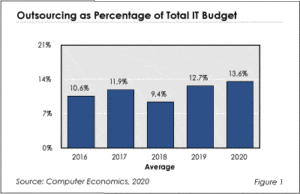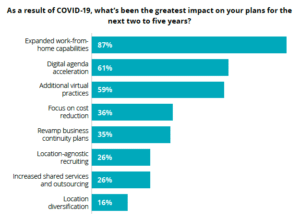The latest stats are in and leave no room for doubt: IT outsourcing services are on the rise, COVID-19 or not.
Computer Economics recently reported that businesses spent an average of 13.6% of their IT budget on outsourcing in 2020, marking a five-year high.

Courtesy of Computer Electronics
But there’s more. 54% of the ~600 respondents in Deloitte’s 2021 Global Shared Services and Outsourcing Survey Report said their organizations work with IT services outsourcing companies in some share or form. Another 25% confirmed that they will invest more in outsourcing services over the next 2–5 years due to the pandemic.

Courtesy of Deloitte
All in all, it’s no wonder the global IT outsourcing market is expected to reach a whopping $425.19 billion by 2026.
But what do all these numbers mean for you?
Simply that if you don’t incorporate IT outsourcing services into your business model, chances are you’ll fall behind the innovation curve and lose your competitive edge.
That being said, if you don’t know what you’re doing, IT outsourcing can do more harm than good. Following certain best industry practices is critical to ensuring the continued success of your outsourcing strategy.
Let’s see what these are.
What Is IT Outsourcing?
IT outsourcing is a business practice whereby a company hires an external service provider to perform some or all of its IT functions, such as strategy and innovation, application development, programming, infrastructure management, and technical support.
Depending on where the outsourcing vendor is based, outsourcing can be classified as onshoring, nearshoring, or offshoring. To learn more about the different outsourcing models and IT outsourcing examples, read our in-depth guide.
Why Do Companies Outsource Software Development?
Businesses turn to IT outsourcing services for multiple reasons, but the following stand out:
- Cost savings: Developer wages vary widely across markets. Often, partnering with an external provider — even one based in a nearby country — can be more cost-effective than hiring in-house staff.
- Larger talent pool: If the local employment market is on the smaller side, highly qualified professionals looking for a new job can be few and far between. Outsourcing allows you to tap into a much broader global talent pool and choose from the best of the best.
- Time savings: By outsourcing fringe or non-essential functions, you can save valuable time and allocate more internal resources to core business activities.
- Less admin: In some cases, working with a provider based in a foreign country comes with a lot less red tape and fewer compliance issues.
For more information on the benefits of outsourcing, read our article on the 5 Benefits of Having an Extended Development Team.
What to Look for in an Outsourcing Partner
These are some of the marks of a good outsourcing partner:
- Competence: To ensure that a third-party vendor can handle the types of services and projects you’re looking to outsource, look into what areas and technologies it specializes in. A great way to check for relevant industry experience is to read the company’s case studies.
- Trustworthiness: While past performance is not necessarily an indication of future results, you can typically gauge a company’s integrity by reading client and employee ratings on sites like Glassdoor. Don’t forget to also check the organization’s security posture, such as any relevant training and ISO certifications.
- Flexibility: Your needs are likely to change over time, so your outsourcing partner must be able to accommodate new requirements quickly and easily.
- Scalability: If you plan to expand your team, workload, or service offering, be sure that any external vendors can scale with you.
- Collaboration: Unless you want to fully outsource a service, you need a partner that can work in tandem with your in-house team. Location matters more than you might think here. An outsourcing company based in a distant country several time zones removed can present more logistical challenges than a provider closer to home.
Keep in mind that these are just the basics — there’s a lot more that goes into outsourcing IT services than that. For a deeper dive into the topic, check out our guides to choosing a good software development company and the top questions to ask software outsourcing providers.
IT Outsourcing Best Practices
Finding a trustworthy outsourcing vendor that can deliver great results is only half the work. Here are some other things to watch out for when setting the terms of your work together:
1. Insist on Collaborative Work Arrangements That Uphold Accountability
The best service providers have a company culture and workflows based on collaboration, feedback loops, and knowledge-sharing. Timely, open, and transparent communication is key in this regard, which is why it’s generally best to have dedicated points of contact for both the technical and business side of things.
2. Look for End-to-End Service Packages
A good outsourcing partner should be able to offer you a full-service package — from recruitment, interviewing, and onboarding to providing the set-up and equipment, managing the outsourced teams, and more.
3. Prioritize Developer Satisfaction
For best results, look for vendors with a strong developer culture where the happiness of their engineers is a top priority. High retention rates are usually an indication of a good working environment, quality business processes, stable teams, and, by extension, happy clients.
Want to learn how to keep your engineers satisfied? Download our definitive guide to building happy development teams.
4. Ensure That You Have the Final Say on Who Joins Your Team
You should always have the option to approve or veto the engineers who join your team. After all, you’ll be the one working with them in the long run.
Your outsourcing provider will typically ask for your input at the final stage of recruitment to make sure you’re happy with the shortlisted candidates. This way, you get the bulk of the hiring process off your shoulders and save valuable time but still make the final decision on who will work on your code.
5. Don’t Neglect IP and Software Security
Last but not least, ensure that you retain all intellectual property rights under the outsourcing contract and probe the vendor’s security posture — certifications such as ISO are a good indicator.
IT Outsourcing Project Example
For a good illustration of software development outsourcing done right, check out our Kaluza case study.
Kaluza, an intelligent platform ecosystem in the energy sector, needed additional developers to meet the growing demand for its cloud solutions.
We interviewed multiple candidates and handpicked four engineers with the required skills. They quickly set to work from their base in Madrid, providing remote support to one of Kaluza’s in-house teams, significantly increasing its capacity in a short period of time.
While our developers were an integral part of Kaluza’s team and contributed to the product’s success, Kaluza owned the results and all intellectual property rights. We also worked under a time-and-materials contract, which allowed Kaluza to grow its team and investment when and as needed.
IT Outsourcing Services with Zartis
Ready to take the next step? Read about our team augmentation services to learn how outsourcing with Zartis can drive cost reductions and help you achieve your business objectives.
Then, get in touch and tell us about your needs. Our outsourcing experts will be happy to answer any questions you may have.


